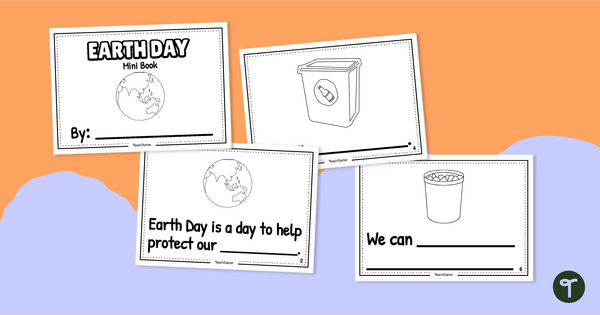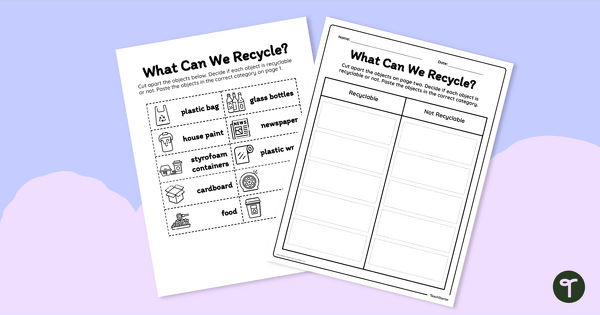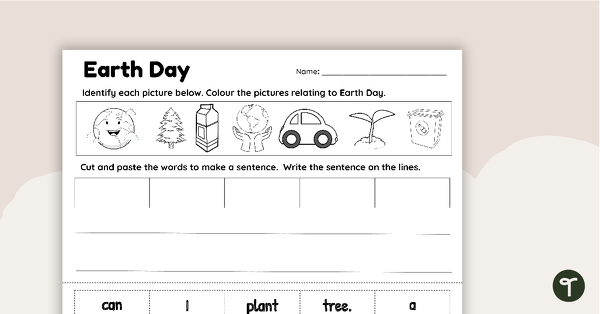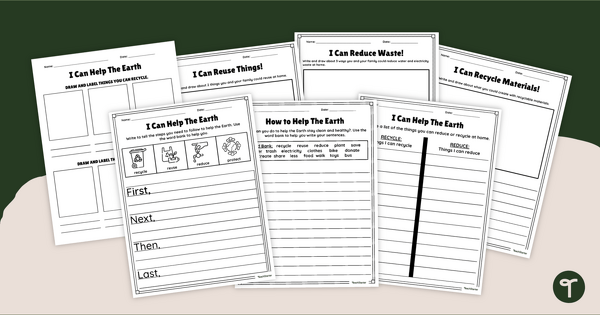Recycling Teaching Resources
Bring the importance of recycling into your sustainability lesson plans with sorting activities for kids, recycling and rubbish bin labels for the classroom and more teacher-created resources to encourage kids to recycle at school and home.
This collection of recycling resources for teachers was created by the teachers of Teach Starter to help you teach your students to lead a more sustainable and environmentally friendly lifestyle. Explore organic and non-organic waste, introduce the three Rs, and build your students' understanding of the ecological consequences of waste production, disposal and recycling with printable and digital activities made with you, your classroom and your students in mind!
Looking for tips to instill the importance of recycling in the classroom? Read on for a primer from our teacher team, including a handy recycling definition you can use with your students, plus some recycling facts for kids that can help get your students hooked on sustainability.
What Is Recycling? A Kid-Friendly Definition
How do you explain what recycling means to your students? Here's a kid-friendly definition you can use!
Recycling is the process of collecting, sorting and processing rubbish so they can be turned into new products. Instead of throwing things away when we're done with them, we give them a new life by transforming them into something useful again.
When we recycle, we separate materials like paper, plastic, glass or metal into special bins.
These materials are collected and sent to facilities where they are transformed into new items. This is how recycling helps us reduce waste and protect our environment.
What Is the Recycling Symbol? How Kids Can Spot This Important Logo
Sometimes called the recycling logo, the recycling symbol is one your students have probably seen over the years — but do they know what it means?
This internationally recognised symbol is made up of three arrows arranged in a triangular shape. The arrows point toward one another to create a continuous loop.
Teach your students to look for this logo on all of the different materials they encounter. It can help them determine if an item can be added to the recycling bin!

What Are the Three R's? A Kid-Friendly Explanation
We mentioned the three R's above, and you've likely heard them plenty of times over the years. But what about your students?
Here's a simple way to help you build on these important principles of recycling with your class!
The three Rs are a helpful way to remember what we can do to make a positive impact.
- Reduce — Reduce means trying to minimise the amount of waste we create in the first place. We can do this by using less packaging or choosing products with less packaging.
- Reuse — When we reuse something, we find new ways to use them instead of throwing them in the bin. For example, your family may take old towels or sheets to the animal shelter to be used as bedding for the dogs who are waiting for homes. This gives them a new life!
- Recycle — Recycling is the final step in the three R's! When we separate the materials that can be reused from our rubbish, it can be sent off to a special facility to be made into a brand-new item that we might find on the store shelves!
6 Recycling Facts for Kids to Get Students' Attention
Do you need a few handy facts about recycling attention to really get your students engaged? Here are some favourites from our teacher team that are almost guaranteed to make them sit up straight and pay attention!
- The recycling symbol used all around the world today was actually created by a uni student in America in 1970. University of Southern California student Gary Anderson entered a competition with his logo, and it ended up becoming a worldwide icon!
- Australia produces 3.5 million tonnes of plastic waste each year, and 130 000 tonnes end up in the ocean around Australia every year.
- Compared to the rest of the world, Australia has the highest consumption of single-use plastic waste per capita. We use 60 kilogrammes each per year!
- According to Planet Ark, in just one year, Australia generated 75.8 mega tonnes (Mt) of total waste. That's equivalent to the weight of 471 Sydney Opera Houses.
- South Australia is the best performing state or territory in the nation when it comes to recycling. South Australians manage to save 80 percent of their rubbish from ending up in landfills!
- Australia has a National Waste Target that we're all responsible for trying to meet! The national goal is to reduce the total waste generated in Australia by 10 percent per person by 2030.
- Plus Plan

Recycling Word Search
Build your students’ vocabulary around the topic of recycling with this recycling-themed word search.
- Plus Plan

Earth Day Craft and Write
Create a fabulous Earth Day display with a printable Earth Day craft activity.
- Plus Plan

Earth Day Mini Book
Help your young students learn and write about Earth Day with a printable Earth Day book for kids.
- Plus Plan

What Can We Recycle? Cut and Paste Worksheet
Remember what to recycle with a cut-and-paste worksheet.
- Plus Plan

How Can We Help Our Planet Mini Book
Help your students learn about how to keep our planet clean with a printable Earth Day book.
- Plus Plan

How is Plastic Recycled? – Recycling Worksheets
Explore the process of recycling plastic with a printable recycling worksheet.
- Plus Plan

Earth Day Mobile - Craft Template
Inspire your students to reduce, reuse, and recycle with a fun Earth Day craft project.
- Free Plan

Building Sentences Earth Day Worksheet (F-1)
Build and write sentences about Earth Day with a printable Earth Day Worksheet for Foundation Year.
- Plus Plan

Earth Day Activity Wheel
Encourage students to get involved in environmental responsibility with this collection of 8 Earth Day activities that focus on Gardner’s Multiple Intelligences.
- Plus Plan

What Can Be Recycled? Poster
A poster showing the products that can be recycled.
- Plus Plan

Reduce, Reuse, Recycle Flipbooks
Display different ways to conserve resources with a set of handy recycling–based foldable interactive notebook templates.
- Plus Plan

Helping the Earth Flipbook
Use this printable recycling flipbook with your students to teach them about ways to help Earth.
- Plus Plan

Write About It! Recycling Writing Prompt Worksheets
Differentiate writing instruction in primary grades with informational writing prompts about recycling and conservation.
- Plus Plan

Save the Planet - Kids Mini Book
Teach your students to reduce, reuse, and recycle with a printable Save the Planet kid's book.
- Free Plan

Save Planet Earth - Science Word Wall Vocabulary
Print and display Earth Day-related terms in your classroom to improve vocabulary and discussion about Earth Day.
- Plus Plan

Recycling Poster Pack
Use our Recycling Poster pack to teach your students about sustainability and conservation.
- Plus Plan

Recycling Writing Prompts
Show off your procedural writing skills with a pack of recycling writing prompts.
- Plus Plan

The Recycling Process Poster
Show your students the process materials go through when they are recycled with printable recycling posters.
- Plus Plan

Reduce, Reuse, Recycle, Rethink and Repair - Brainstorming Sheets
Brainstorm All the Ways to Reduce, Reuse, and Recycle with a pack of printable brainstorming worksheets.
- Plus Plan

Reduce, Reuse, Recycle - Environmental Word Wall
Help your students learn about recycling and conservation with an illustrated word wall.
- Plus Plan

Student Lunch Box Audit - Reducing Waste Project
An investigation that will have students calculating the waste produced from their lunch boxes, creating a plan of action to reduce their waste and reflecting on their results.
- Plus Plan

Earth Day Write the Room - Kindergarten/Foundation
Help your young students learn and write about Earth Day with an Earth Day Write The Room Kindergarten Activity Pack.
- Plus Plan

Recycling Craft - We Recycle Because...
Write about why we recycle and create this recycling craft to display in the classroom.
- Plus Plan

Waste Management Investigation - How Much Waste Do We Throw Away?
A practical investigation related to sustainable waste management.
-

10 Recycling Activities for Kids to Add to Your Lesson Plans This School Year
Looking for fun and engaging recycling activities for kids? Check out these 10 easy ideas plus free recycling reward schemes for teachers.